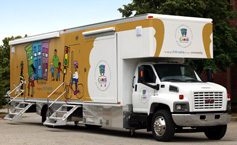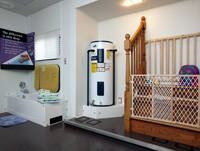New Mobile Safety Center Announced
Johns Hopkins Center for Injury Research and Policy and CDC Celebrate A Decade of Progress in Injury Prevention and Control
 A new Mobile Safety Center will soon be traveling the streets of Baltimore with the goal of making injury prevention information and safety products more accessible to families. The Mobile Safety Center is designed as a house-on-wheels and will simulate the hidden injury risks lurking in every home. Launched by the Johns Hopkins Children’s Safety Center, a service of the Center for Injury Research and Policy at the Johns Hopkins Bloomberg School of Public Health, it is one of two new initiatives to keep children safe from unintentional injury, which is the leading cause of death nationwide for children. The second initiative is the release of the newly published Johns Hopkins Children’s Safety Center Replication Guide, which will help other child advocates create safety programs in their own communities. Both initiatives will be announced at a news conference held on June 20, 2002, in Baltimore, Maryland.
A new Mobile Safety Center will soon be traveling the streets of Baltimore with the goal of making injury prevention information and safety products more accessible to families. The Mobile Safety Center is designed as a house-on-wheels and will simulate the hidden injury risks lurking in every home. Launched by the Johns Hopkins Children’s Safety Center, a service of the Center for Injury Research and Policy at the Johns Hopkins Bloomberg School of Public Health, it is one of two new initiatives to keep children safe from unintentional injury, which is the leading cause of death nationwide for children. The second initiative is the release of the newly published Johns Hopkins Children’s Safety Center Replication Guide, which will help other child advocates create safety programs in their own communities. Both initiatives will be announced at a news conference held on June 20, 2002, in Baltimore, Maryland.
The announcement also marked the beginning of a daylong injury prevention symposium, “Models of Safety.” The symposium celebrates the 10th anniversary of the establishment of the Centers for Disease Control and Prevention (CDC) National Center for Injury Prevention and Control and its ongoing efforts with the Center for Injury Research and Policy at the Johns Hopkins Bloomberg School of Public Health. Injury prevention researchers and practitioners from the region gathered to discuss model injury prevention research, policies and programs, and the importance of strong partnerships between academic research, public health practitioners, and the community. Regional workshops have also been held in Denver, Boston, and Los Angeles. These events highlight successes in injury prevention fostered by CDC injury research and state program funding.
The Mobile Safety Center is a cooperative project between the Baltimore City Fire Department, the Johns Hopkins Bloomberg School of Public Health, and Johns Hopkins Medical Institutions. It is based on the success of the Johns Hopkins Children’s Safety Center (CSC), which is located in the Johns Hopkins Children’s Center. Earlier this year, an assessment of the Children’s Safety Center, published in theArchives of Pediatric and Adolescent Medicine, found that parents of young children who visited the Center were twice as likely to observe safety practices in their homes than those who did not.
 “The CSC is an effective way to reach those families who come into the hospital, but the Mobile Safety Center will allow us to provide potentially life-saving education and safety products to many more families throughout Baltimore,” says Eileen M. McDonald, MS, program director of the Children’s Safety Center and assistant scientist in health policy and management at the Johns Hopkins Bloomberg School of Public Health.
“The CSC is an effective way to reach those families who come into the hospital, but the Mobile Safety Center will allow us to provide potentially life-saving education and safety products to many more families throughout Baltimore,” says Eileen M. McDonald, MS, program director of the Children’s Safety Center and assistant scientist in health policy and management at the Johns Hopkins Bloomberg School of Public Health.
The Mobile Safety Center is funded in part by a grant from BP. The 40-foot tractor-trailer contains a kitchen, bedroom, bathroom, and stairway that illustrate potential hazards in a typical home. An onboard smoke generator and heating elements will simulate the conditions inside a home during a fire. Trained instructors will use the facility to illustrate for children and parents the proper safety techniques to avoid burns, falls, strangulation, poisoning, and other unintended injuries in their homes and neighborhoods. The trailer will also be equipped with an inventory of safety products, including such items as safety gates, cabinet locks, bike helmets, and car seats, which will be offered for sale at below-retail costs.
“Our mission with the Mobile Safety Center is to promote the safety of children and families by delivering fun, interactive education, and affordable safety products to the community,” says Andrea C. Gielen, ScD, Deputy Director of the Johns Hopkins Center for Injury Research and Policy and professor of health policy and management at the Johns Hopkins Bloomberg School of Public Health. “Baltimore needs a service like the Mobile Safety Center. Every year more than one thousand Baltimore children are hospitalized as a result of an injury – that’s almost 3 children every day who do not need to be suffering from these preventable injuries,” adds Dr. Gielen.
The Mobile Safety Center is scheduled to be on the road in the fall of 2003. At the news conference, reporters will see a computer-animated virtual tour of the Mobile Safety Center and a tabletop model of the vehicle, both of which were created by faculty and students from the Maryland Institute College of Art.
Also on June 20, the Children’s Safety Center released the Johns Hopkins Children’s Safety Center Replication Guide. The 65-page booklet, published with support from the Lowe’s Safety Council, contains step-by-step instructions to help other communities develop safety centers similar to the one in Baltimore. After considering that 6,700 children in the United States die and another 50,000 are disabled from unintentional injuries each year, McDonald and Gielen, the guide’s authors, hope the Replication Guide will promote the importance of pediatric injury prevention and encourage other communities to create their own safety centers.
Members of the Hopkins injury center concluded the day’s celebration with a dinner at the Peabody Library honoring Professor Susan Baker, MPH, who is a pioneer in injury prevention and the first director of the Johns Hopkins Center for Injury Research and Policy. Her history with the School dates back to 1968 when she began teaching the first injury control course. Distinguished guests from Baltimore and throughout the country, many of whom were trained by the Hopkins injury center, will be on hand to comment on and celebrate the accomplishments of Professor Baker and the injury center.
Replication Guide Ordering Information
Public Affairs Media Contact for the Johns Hopkins Bloomberg School of Public Health: Tim Parsons @ 410.955.6878 or paffairs@jhsph.edu .